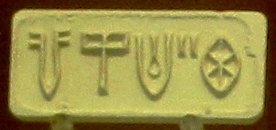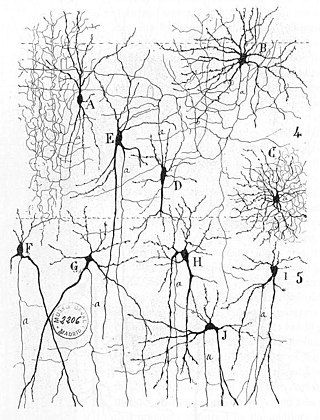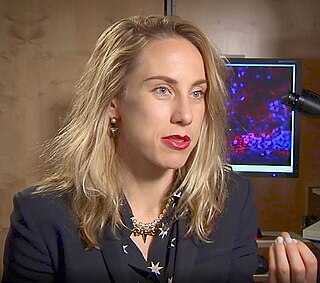
Computational biology refers to the use of data analysis, mathematical modeling and computational simulations to understand biological systems and relationships. An intersection of computer science, biology, and big data, the field also has foundations in applied mathematics, chemistry, and genetics. It differs from biological computing, a subfield of computer science and engineering which uses bioengineering to build computers.

Mind uploading is a speculative process of whole brain emulation in which a brain scan is used to completely emulate the mental state of the individual in a digital computer. The computer would then run a simulation of the brain's information processing, such that it would respond in essentially the same way as the original brain and experience having a sentient conscious mind.
Neuromorphic computing is an approach to computing that is inspired by the structure and function of the human brain. A neuromorphic computer/chip is any device that uses physical artificial neurons to do computations. In recent times, the term neuromorphic has been used to describe analog, digital, mixed-mode analog/digital VLSI, and software systems that implement models of neural systems. The implementation of neuromorphic computing on the hardware level can be realized by oxide-based memristors, spintronic memories, threshold switches, transistors, among others. Training software-based neuromorphic systems of spiking neural networks can be achieved using error backpropagation, e.g., using Python based frameworks such as snnTorch, or using canonical learning rules from the biological learning literature, e.g., using BindsNet.

A brain–computer interface (BCI), sometimes called a brain–machine interface (BMI) or smartbrain, is a direct communication pathway between the brain's electrical activity and an external device, most commonly a computer or robotic limb. BCIs are often directed at researching, mapping, assisting, augmenting, or repairing human cognitive or sensory-motor functions. They are often conceptualized as a human–machine interface that skips the intermediary component of the physical movement of body parts, although they also raise the possibility of the erasure of the discreteness of brain and machine. Implementations of BCIs range from non-invasive and partially invasive to invasive, based on how close electrodes get to brain tissue.

The Indus script, also known as the Harappan script, is a corpus of symbols produced by the Indus Valley Civilisation. Most inscriptions containing these symbols are extremely short, making it difficult to judge whether or not they constituted a writing system used to record the as-yet unidentified language(s) of the Indus Valley Civilisation. Despite many attempts, the 'script' has not yet been deciphered, but efforts are ongoing. There is no known bilingual inscription to help decipher the script, which shows no significant changes over time. However, some of the syntax varies depending upon location.

Miguel Ângelo Laporta Nicolelis, M.D., Ph.D., is a Brazilian scientist, physician and Duke School of Medicine Professor in Neuroscience at Duke University, best known for his pioneering work surrounding brain-computer interface technology.

Navaratna Srinivasa Rajaram was an Indian academic and a Hindutva ideologue. He is notable for propounding the "Indigenous Aryans" hypothesis, asserting that the Vedic period was extremely advanced from a scientific view-point, and claiming of having deciphered the Indus script. Academics find his scholarship to be composed of dishonest polemics in service of a communal agenda.

A wetware computer is an organic computer composed of organic material "wetware" such as "living" neurons. Wetware computers composed of neurons are different than conventional computers because they use biological materials, and offer the possibility of substantially more energy-efficient computing. While a wetware computer is still largely conceptual, there has been limited success with construction and prototyping, which has acted as a proof of the concept's realistic application to computing in the future. The most notable prototypes have stemmed from the research completed by biological engineer William Ditto during his time at the Georgia Institute of Technology. His work constructing a simple neurocomputer capable of basic addition from leech neurons in 1999 was a significant discovery for the concept. This research acted as a primary example driving interest in the creation of these artificially constructed, but still organic brains.
Neuroinformatics is the field that combines informatics and neuroscience. Neuroinformatics is related with neuroscience data and information processing by artificial neural networks. There are three main directions where neuroinformatics has to be applied:
Neurorobotics is the combined study of neuroscience, robotics, and artificial intelligence. It is the science and technology of embodied autonomous neural systems. Neural systems include brain-inspired algorithms, computational models of biological neural networks and actual biological systems. Such neural systems can be embodied in machines with mechanic or any other forms of physical actuation. This includes robots, prosthetic or wearable systems but also, at smaller scale, micro-machines and, at the larger scales, furniture and infrastructures.
The Roja Muthiah Research Library (RMRL), in Chennai, India, was founded in 1994, and opened to researchers in 1996; it provides research materials for Tamil studies in a variety of fields of the humanities, social sciences, and sciences. The Library is based on the collection of Roja Muthiah, who accumulated one of the world's finest private libraries of Tamil publications.
Dana Harry Ballard (1946–2022) was a professor of computer science at the University of Texas at Austin and formerly with the University of Rochester.
The concept of biological computation proposes that living organisms perform computations, and that as such, abstract ideas of information and computation may be key to understanding biology. As a field, biological computation can include the study of the systems biology computations performed by biota the design of algorithms inspired by the computational methods of biota, the design and engineering of manufactured computational devices using synthetic biology components and computer methods for the analysis of biological data, elsewhere called computational biology or bioinformatics.
A brain–brain interface is a direct communication pathway between the brain of one animal and the brain of another animal.
In neuroscience, predictive coding is a theory of brain function which postulates that the brain is constantly generating and updating a "mental model" of the environment. According to the theory, such a mental model is used to predict input signals from the senses that are then compared with the actual input signals from those senses. With the rising popularity of representation learning, the theory is being actively pursued and applied in machine learning and related fields.
Mona Singh is a Professor of Computer Science in the Lewis-Sigler Institute for Integrative Genomics at Princeton University.

Manolis Kellis is a professor of Computer Science at the Massachusetts Institute of Technology (MIT) in the area of Computational Biology and a member of the Broad Institute of MIT and Harvard. He is the head of the Computational Biology Group at MIT and is a Principal Investigator in the Computer Science and Artificial Intelligence Lab (CSAIL) at MIT.

Polina Olegovna Anikeeva is a Russian-born American materials scientist who is a Professor of Material Science & Engineering as well as Brain & Cognitive Sciences at the Massachusetts Institute of Technology (MIT). She also holds faculty appointments in the McGovern Institute for Brain Research and Research Laboratory of Electronics at MIT. Her research is centered on developing tools for studying the underlying molecular and cellular bases of behavior and neurological diseases. She was awarded the 2018 Vilcek Foundation Prize for Creative Promise in Biomedical Science, the 2020 MacVicar Faculty Fellowship at MIT, and in 2015 was named a MIT Technology Review Innovator Under 35.

The Robert J. & Nancy D. Carney Institute for Brain Science is a cross-departamental neuroscience research institute at Brown University in Providence, Rhode Island. The institute's core focus areas include brain-computer interfaces and computational neuroscience The institute also focuses on research into mechanisms of cell death with the interest of developing therapies for neurodegenerative diseases.









